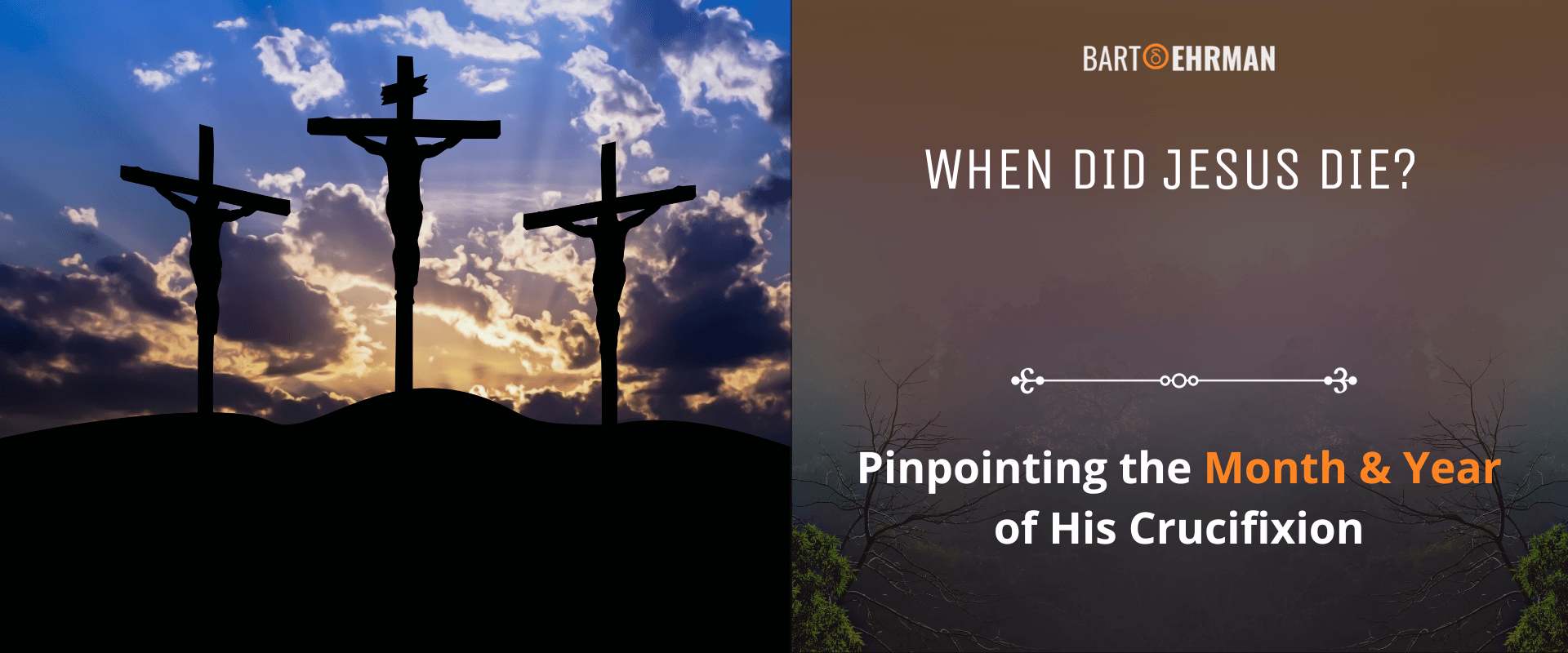When Did Jesus Die? Unveiling the Month & Year of His Crucifixion

Written by Joshua Schachterle, Ph.D
Author | Professor | Scholar
Author | Professor | BE Contributor
Verified! See our editorial guidelines
Verified! See our guidelines
Date written: January 9th, 2024
Disclaimer: The views and opinions expressed in this article belong to the author and do not necessarily match my own. - Dr. Bart D. Ehrman
It may surprise you to know that there is still scholarly debate about when Jesus died.
It’s very difficult, even for trained historians, to pinpoint exact dates from the ancient world. Ancient cultures had calendars that differed from our modern Gregorian calendar. While we can often calculate the approximate dates of important events, determining them perfectly is nearly impossible in most cases.
In addition, it’s difficult to know which ancient sources to trust about significant historical occurrences. When those sources disagree about the chronology of an event, for example, we are left with sorting out which is more plausible.
Having said that, I’ve already written about what day of the week Jesus died. In this article, I’ll address the question of the exact month and year of the crucifixion.

Sources for Jesus’ Death: the Gospels
Our most obvious sources are the four canonical Gospels. In terms of the chronology of Jesus’ death, we can divide them into the Synoptic Gospels (Matthew, Mark, and Luke) on one side and John on the other.
In the Synoptics, the Last Supper happens on the first night of the Jewish festival of Passover. According to the Torah, specifically Leviticus 23:5-6, this should have been on the 14th day of the Jewish month of Nisan which would generally correspond with March or April on our calendar. (More on that shortly). Then the crucifixion occurs on the next day or the 15th day of Nisan.
In John, however, the trial of Jesus takes place the day before Passover begins, which means that the crucifixion happens on the 14th day of Nisan. These two versions can’t be reconciled chronologically.
However, Bart Ehrman notes that in the Gospel of John “Jesus’ death represents the salvation of God, just as the sacrifice of the lamb represented salvation for the ancient Israelites during the first Passover.”
He goes on to write that because of this, it is far more likely that the author of John changed the traditional date of Jesus’ death so that it wouldn’t coincide with Passover. Why? Because Jesus himself was the sacrificial Lamb. As Bart says, “Perhaps John (or his source) made a change in the day and hour of Jesus’ death precisely to reinforce this theological point.”
So, although they disagree about the day, the Synoptics and John both give us the month when Jesus was killed, although they don’t give us the year.
What Can The Letters of Paul Tell Us About When Jesus Died?
One way that scholars have attempted to figure out the year of Jesus’ death is by using some remarks made by Paul in his letters along with accounts of Paul’s trial in Acts, which we can date to 51 or 52 CE (If Acts is historically accurate – a big “if”).
So, without going into too much detail, we can work backwards from that date based on what Paul says about his ministry, then further back toward his conversion. According to Bart Ehrman, the chronology gives us a date of 32-33 CE for Paul’s conversion.
If this is accurate, and if we assume that Paul had been persecuting Christians for a while before converting, we can venture a guess of an approximate year of 30 CE for Jesus’ crucifixion. I should point out, though, that this is highly speculative and again, depends entirely on the questionable accuracy of the date of Paul’s trial given in Acts.
FREE COURSE!
WHY I AM NOT A CHRISTIAN
Raw, honest, and enlightening. Bart's story of why he deconverted from the Christian faith.
Over 6,000 enrolled!
Non-Christian Sources on Jesus’ Crucifixion
The Gospels say that Pontius Pilate condemned Jesus to death. What do we know about Pilate?
Pilate was appointed governor of the Roman province of Judaea when Tiberius was the emperor of Rome from 14 CE to 37 CE. We don’t know how he got this job, but we do know approximately when he had it thanks to one of our ancient sources.
The Jewish historian Flavius Josephus is one of our most valuable non-Christian sources. In his Antiquities of the Jews, he writes this:
when Pilate, at the suggestion of the principal men among us, had condemned [Jesus] to the cross, those that loved him at the first did not forsake him.
So, agreeing with the Gospels, Josephus writes that Jesus was indeed condemned to death by Pontius Pilate. What’s also important for dating Jesus’ crucifixion, is that Josephus says that Pilate was governor of Judea from 26 to 36/37 CE.
This means that we can date the crucifixion within that 10-11-year period, although the exact year is still elusive.
The fact that Jesus was killed by order of Pontius Pilate is also attested by Roman historian Tacitus. Tacitus, writing about Christians, says that
Christus, from whom the name had its origin, suffered the extreme penalty during the reign of Tiberius at the hands of one of our procurators, Pontius Pilate…
While this still doesn’t give us an exact year, it gives us historical confirmation of what Josephus wrote and limits the possible range of Jesus’ death to 26-37 CE.
So, given all these sources, what is the scholarly consensus about the year and month Jesus died?
What Year Did Jesus Die?
Using the sources above, can we calculate the year of Jesus’ death with any accuracy? Let’s see.
First, the dates of the Jewish calendar were determined by the moon. Specifically, the 15th day of Nisan was on the first full moon night following the spring equinox. Since the Synoptic Gospels say that the Last Supper happened on a Friday, astronomers can calculate by the phases of the moon which years during the reign of Pontius Pilate had Passover beginning on a Friday (this would be Thursday night for us, since the Jewish day begins and ends at sundown).
There are only two: 30 CE and 33 CE. While either of these years is certainly plausible, most scholars think that 30 CE is a more likely year, based on the scholarly consensus I mentioned above working back from Paul’s letters and the book of Acts.
The only problem is that this is calculated by assuming that our information in the Synoptic Gospels and the book of Acts are 100% historically accurate. As an historian, I know that we can never know that for certain.
What Month Did Jesus Die?
If we accept the Gospels’ account that Jesus died during the Passover festival, we can know the month in the Jewish calendar that he died. As I mentioned above, Passover in the Torah was to begin on the 14th day of the month of Nisan. But which month in our current calendar corresponds to the month of Nisan? It’s complicated.
Unlike our exclusively solar calendar, the Jewish calendar is both lunar and solar. It’s constructed on lunar months, some with 29 days and some with 30. But the average length of the lunar year is also regulated to the solar year by introducing occasional leap years in order to make sure the major Jewish holidays occur at the proper times.
Because of this, there isn’t a perfect correspondence between our months and Jewish months. Having said that, Nisan generally corresponds either to March, April, or an overlapping of both.
If we base it on the astronomical calculations I mentioned above, Nisan 14th in the year 30 CE would have fallen in April. It is historically plausible, then, that Jesus died in April of the year 30 CE.

How Can Some Authors Claim an Exact Date for the Crucifixion?
At least one author, Andreas Köstenberger, claims to have determined an exact date for Jesus’ death: April 3, 33 CE. This is a date arrived at both by reading the Synoptic Gospel accounts in which Jesus ate his Last Supper as a Passover Meal on (our) Thursday night, and then calculating the dates of the month of Nisan on which this Last Supper could have occurred on a Thursday night (extending, as the Jewish calendar does, into Friday morning as the same day).
When this calculation is made, this author says that we can definitively say that Jesus died on April 3, 33 CE. However, there are some problems with this idea.
First and foremost, we can only put a definitive date on Jesus’ crucifixion by claiming perfect certainty that Mark and the other Synoptics were historically accurate. Why is this unlikely?
In the first place, Mark, our earliest Gospel, was written four decades after Jesus’ death. Matthew and Luke were written at least five decades after his death. The further you get away from an historical event, the less likely it becomes that the author has all the details correct.
It’s also important here to note that the Gospels were not written as history, in the modern sense of the word. As famed biblical scholar E.P. Sanders writes, "these Gospels were written with the intention of glorifying Jesus and are not strictly biographical in nature." In addition, Ingrid Maisch and Anton Vögtle write that the gospels were written as theological, not historical documents.
It’s not that the Gospel writers tried to write historical books and failed. They wrote theological works with some history thrown in. This doesn’t mean that there is no historically accurate information in them, but it does mean that we can never be 100% certain which of the events described in them is historically accurate.
This is part of the reason that the Gospels contradict each other and sometimes even contradict themselves. The purpose of the Gospel writers was not to give a perfectly accurate account of the life of Jesus but to state who they believed Jesus to be. For anyone interested in this topic, I highly recommend Bart Ehrman’s book Jesus, Interrupted: Revealing the Hidden Contradictions in the Bible (And Why We Don't Know About Them).
So, in order to even make accurate calculations about the exact date of Jesus’ death, we would need absolute certainty about the accuracy of the Gospel accounts. Unfortunately, we will never have this.
Conclusion: When Did Jesus Die?
The Synoptic Gospels say that Jesus was killed on a Passover Friday, which in the Jewish calendar started on our Thursday night, and that he was killed the next day.
In addition, we know that the traditional date of Passover, Nisan 14th, was determined by the first full moon night after the spring equinox. Our sources, Christian and otherwise, also say that Jesus was killed by order of Pontius Pilate who governed Judea from 26 to 36/37 CE. During that period, only two years had Passovers starting on Friday (Thursday night): 30 and 33 CE.
The truth is that either of those years could be accurate. There is no absolute way of determining which is the year of Jesus’ death.
Determining the month is much easier. Most scholars assume that the Synoptic Gospels, which agree on the chronology of the crucifixion, are more accurate than John, since Mark is our earliest Gospel and serves as a source for Matthew and Luke.
According to Mark, Jesus ate his Last Supper as a Passover meal on our Thursday night in the month of Nisan. In fact, if we assume, as most scholars do, that Jesus was killed during the festival of Passover, it’s fairly easy to know that he died during Nisan. In Jesus' time, that would likely have put his death in our month of April.
FREE COURSE!
WHY I AM NOT A CHRISTIAN
Raw, honest, and enlightening. Bart's story of why he deconverted from the Christian faith.
Over 6,000 enrolled!
